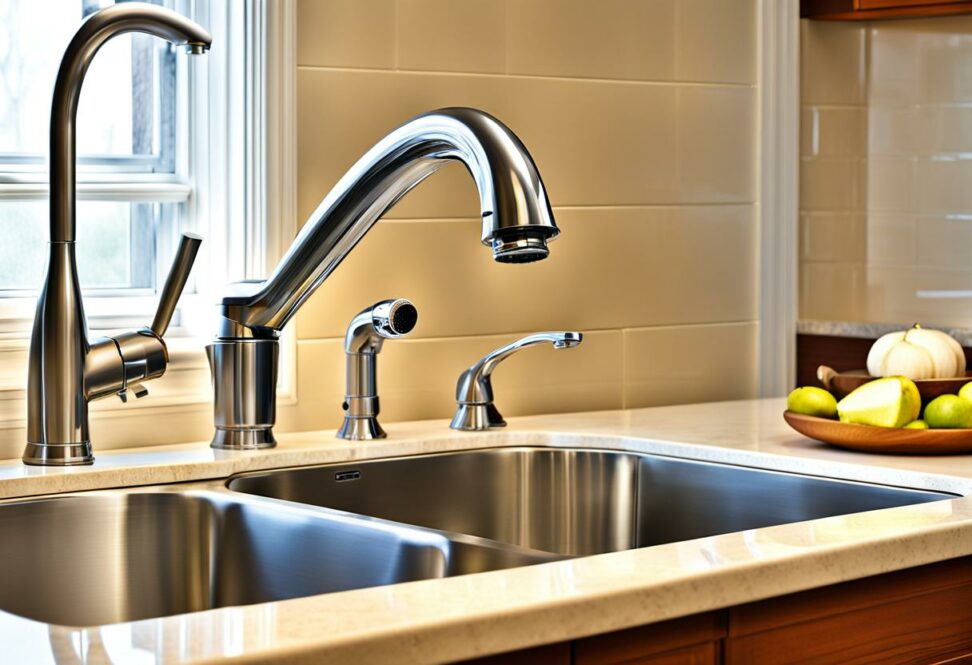Kitchen Faucet Parts - Named and Explained
Kitchen faucets may seem simple on the outside, but within that chrome exterior lies a complex array of parts that control the flow and mix of water into your sink. Understanding what's inside your faucet and the role each component plays will empower you to tackle minor repairs and keep things running smoothly.
You'll learn the name and function of each major external and internal part. Consider this your insider's guide to the anatomy of one of the hardest working fixtures in your kitchen.
External Faucet Parts
Let's start with the external parts you see and interact with on a daily basis.
Faucet Handle
The faucet handle is the control center, allowing you to turn water on and off and adjust temperature. Handles come in several styles including single lever, cross handle, widespread, and hands-free touch activation.

No matter the design, the handle attaches to the faucet body and moves internal components to control water flow and mix.
Faucet Spout
The faucet spout is the arched "neck" that extends out over your sink. This curved piece connects to the faucet body and provides a directed stream of water right where you need it.
Spouts come in a high arc or lower gooseneck shape. Many feature a pull-out spray head for added functionality.
Faucet Body
The main external body contains the bulk of the faucet's working components. Constructed of solid brass beneath a chrome finish, this housing anchors the spout and handle(s).
Style varies, but the body contains the critical inner workings regardless of design.
Faucet Base
The base secures the faucet to the countertop or sink deck. This bottom portion has holes for supply line connections and conceals mounting hardware.
A bonnet nut threaded onto the base holds the faucet body firmly in place.
Aerator
The small screen on the tip of the faucet spout is the aerator. It mixes air into the water flow to prevent splashing.
Aerators are removable for cleaning and many include an anti-sweat device to prevent condensation.
Internal Faucet Components
Now let's look at the critical components concealed inside the faucet body.
Cartridge
The cartridge controls water flow and the mix of hot and cold. This part moves up/down for volume and left/right to adjust temperature.
Cartridges are usually made of plastic or ceramic surrounded by rubber seals and lubricated with grease.
Valves
Hot and cold inlet valves inside the faucet body allow water to flow into the system. These valves seal off when the faucet is off and open when the cartridge directs.
Washerless designs use cartridges and O-rings rather than separate washers to prevent leaks.
Stem
The stem connects the handle to the cartridge and transfers motion to control flow. Up/down stem movement increases or decreases water volume.
Rotating the stem side-to-side shifts between hot and cold.
Seat Washers
These rubber gaskets provide a watertight seal between valve components. Washers fit into valve "seats" and compress when valves close to prevent drips.
Faucet washers show wear over time and may need occasional replacement.
O-Rings
O-rings create flexible, watertight seals at moving joints throughout the faucet. They prevent leaks around spouts, stems, and where components connect.
O-rings require occasional lubrication to stay supple and keep water where it belongs.
Faucet Connections
Finally, flexible supply lines and mounting hardware connect the faucet to your water supply and sink.
Supply Lines
Flexible braided steel hoses connect to the hot and cold inlet valves inside the faucet. Supply lines deliver water up through the body to the spout.
A bad or leaking supply line is easy to replace without removing the whole faucet.
Mounting Hardware
Faucet mounting nuts and washers anchor the base to pre-drilled holes in your sink deck or countertop.
Underneath, the bonnet nut threads upward to secure the faucet body to the base.
While faucets may seem simple from the outside, complex and precise internal parts work in unison to deliver water just how you need it. Knowing the name and function of each piece will help you keep your kitchen faucet running smoothly for years to come.